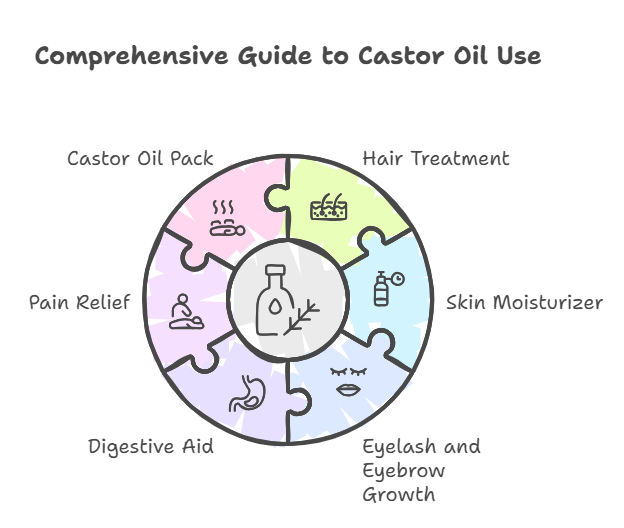Castor oil, a thick, viscous liquid, carries a legacy spanning centuries, often hailed as a versatile natural remedy. Extracted from the seeds of the Ricinus communis plant, this oil is more than just a historical footnote; it’s popular today for health and beauty applications.
“Castor oil is filled with omega-6, omega-9, and vitamin E, which all have nourishing and hydrating factors. It is also an anti-inflammatory and antibacterial, and has humectant properties, which means it attracts moisture and keeps the skin hydrated.
Dr. Marina Peredo
You might wonder what makes this ancient oil so enduringly relevant; let’s explore the wide-ranging uses and potential advantages of castor oil.
What is Castor Oil?
Castor oil is a vegetable oil produced by pressing the seeds of the castor bean plant. It stands out due to its high concentration of ricinoleic acid, a monounsaturated fatty acid comprising about 90% of its composition.
This specific fatty acid is thought to be responsible for many of castor oil’s notable properties.
The oil itself is typically thick, ranging from clear or pale yellow (when cold-pressed) to a darker brown-black (associated with Jamaican Black Castor Oil, or JBCO)1.
Its use traces back thousands of years, finding mentions in ancient Egyptian medical texts like the Ebers Papyrus for applications ranging from eye protection to inducing labor. This historical context highlights its long-standing role as a natural remedy.
There are different processing methods. Cold-pressed oil involves extracting the oil without heat, preserving more nutrients. Jamaican Black Castor Oil involves roasting the beans first, then boiling and pressing them, resulting in a darker color, nuttier aroma, and ash content believed by some to enhance its benefits, particularly for hair.
10 Potential Benefits of Castor Oil
Castor oil is associated with a variety of health and cosmetic benefits. While scientific evidence varies for different uses, anecdotal reports and traditional practices support its application for several conditions. Here are ten potential advantages:
Promotes Hair Growth
Many individuals turn to this oil hoping for longer, thicker hair, using it as a hair growth stimulant. The theory centers on ricinoleic acid, which might improve blood flow to the scalp when massaged in. Improved circulation could nourish hair follicles, potentially leading to stronger growth.
While rigorous clinical trials are limited, personal accounts often describe reduced hair breakage and increased fullness. Both standard cold-pressed oil and Jamaican Black Castor Oil are popular choices for hair treatments. The thick consistency coats the hair shaft, possibly reducing damage and increasing shine2.
To use it for hair, massage a small amount into the scalp and through the hair strands. Due to its thickness, mixing it with a lighter carrier oil like coconut or jojoba oil can make application easier. Covering hair with a shower cap and leaving it on for at least 30 minutes, or even overnight, before washing thoroughly is a common method.
Moisturizes Skin
Castor oil acts as an effective emollient and occlusive moisturizer, beneficial for skin hydration. It helps soften dry, rough skin and creates a protective barrier to reduce moisture loss. Its fatty acids, particularly ricinoleic acid, draw moisture into the skin, making it a good option for hands, feet, elbows, and knees.
Unlike some commercial moisturizers containing potential irritants, pure oil is a simple, natural option. Some people even use it carefully on the face, though its thickness might be too heavy for oily or acne-prone skin types; a patch test is crucial. Its humectant properties mean it can help maintain skin suppleness.
If you’re interested in the broader benefits of natural oils, including their calming effects, check out our guide on the 12 best natural oils for anxiety relief.
Applying a thin layer to clean, damp skin helps lock in hydration. It can be used alone or mixed with other beneficial oils. Remember that a little goes a long way due to its rich texture.
Reduces Inflammation
The high concentration of ricinoleic acid gives castor oil significant anti-inflammatory properties. When applied topically, it may help soothe inflammation associated with various skin conditions like dermatitis or sunburn. It penetrates the skin layers, potentially calming irritated tissues.
This anti-inflammatory action is also the basis for its use in relieving joint pain, such as in arthritis. By reducing localized inflammation, it might offer temporary relief from swelling and discomfort. It’s often applied through gentle massage or using castor oil packs3.
Further research is needed to fully understand the mechanisms and effectiveness compared to standard anti-inflammatory treatments. However, its gentle nature makes it a popular complementary approach for managing localized inflammation. Always consult a doctor for persistent or severe inflammation.
Supports Digestive Health
Castor oil is well-known as a powerful stimulant laxative for constipation relief. When taken orally, ricinoleic acid gets released in the small intestine, where it irritates the intestinal lining. This irritation stimulates muscle contractions (peristalsis), helping to move stool through the bowels.
Its effects are typically strong and relatively fast-acting, usually producing a bowel movement within 2 to 6 hours. Because of its potency, it’s generally recommended only for occasional, severe constipation and under the guidance of a healthcare professional. It’s not suitable for chronic constipation or long-term use.
Taking castor oil orally can cause side effects like cramping, nausea, and diarrhea, potentially leading to dehydration if not managed carefully. Pregnant women should avoid oral castor oil as it can induce uterine contractions. Careful dosing is essential; always follow medical advice.
Boosts Immune Function
Some alternative health theories propose that topical application of castor oil, particularly through castor oil packs, may support the immune system.
The idea is that the oil absorbed through the skin stimulates lymphatic drainage and increases the count of lymphocytes, specifically T-cells. T-cells are vital components of the immune system, identifying and killing pathogens.
Limited studies from the alternative medicine field have suggested a temporary increase in lymphocyte counts following castor oil pack application.
However, these studies are often small and lack rigorous controls. Mainstream scientific evidence confirming a significant, lasting impact on overall immune function is currently insufficient.
Despite the lack of robust proof, castor oil packs remain a popular practice in some holistic health circles for general wellness and immune support. They are typically placed over the abdomen or other areas needing attention. Consultation with a healthcare provider is recommended before using it for immune purposes.
Enhances Wound Healing
Castor oil may offer wound healing support for minor cuts, scrapes, and abrasions. Its antimicrobial properties can help prevent infection, while its anti-inflammatory action may reduce localized swelling and pain. It also creates a moist environment, which is generally considered beneficial for the healing process.
Some ointments used in clinical settings for wound care actually contain castor oil as an ingredient, often combined with other substances like Peru balsam.
It acts as a protective barrier, preventing the wound from drying out too quickly. This can help reduce scarring and speed up tissue repair4.
For home use on minor injuries, applying a small amount of castor oil under a sterile bandage might be helpful after cleaning the wound thoroughly. However, it should not be used on deep or infected wounds; serious injuries require professional medical attention.
Improves Eyebrow and Eyelash Growth
Similar to its use on scalp hair, castor oil is frequently applied to eyebrows and eyelashes for potential eyelash enhancement and brow thickening.
The rationale is the same: moisturizing the hairs, potentially reducing breakage, and stimulating follicles through improved circulation or ricinoleic acid’s effects. Many beauty routines now incorporate organic castor oil for this purpose.
While direct evidence proving it makes lashes or brows grow significantly longer or faster is scarce, many users report positive results anecdotally.
The conditioning effect can certainly make existing hairs appear healthier, darker, and fuller. Consistency seems to be important for seeing any perceived changes.
Application requires care to avoid getting oil directly into the eyes. Using a clean mascara wand or cotton swab, apply a tiny amount along the lash line and through the brows, typically before bed. If irritation occurs, discontinue use immediately.
Relieves Arthritis Pain
Thanks to its anti-inflammatory properties, castor oil is sometimes used topically for arthritis pain management. Massaging the oil into arthritic joints, like knees or hands, may help reduce localized pain and stiffness5. The ricinoleic acid is believed to be the active component responsible for this effect.
Applying heat after the massage, perhaps with a heating pad or warm towel (being careful not to burn the skin), can enhance the oil’s penetration and provide additional soothing warmth.
This approach may offer temporary relief for some individuals experiencing mild to moderate arthritis discomfort. It works best as a complementary therapy alongside conventional treatments.
It’s important to remember that castor oil does not cure arthritis but may help manage symptoms. Discussing its use with a doctor is important, especially if using other arthritis medications. Many prefer cold-pressed castor oil for its purity in these applications.
Fights Fungal Infections
Castor oil exhibits antifungal properties, making it a potential natural antifungal treatment for certain types of infections. Undecylenic acid, a derivative of ricinoleic acid found in castor oil, is known for its fungicidal activity. This makes castor oil a candidate for addressing skin issues like ringworm or athlete’s foot.
It might also be helpful against Candida albicans overgrowth on the skin or nails. Applying castor oil directly to the affected area might help inhibit fungal growth.
Some people mix it with other antifungal agents like tea tree oil for enhanced effect, though patch testing is essential due to potential irritation.
While promising, castor oil shouldn’t replace prescribed antifungal medications for persistent or severe infections. It can be a supportive measure, but consult a healthcare professional for proper diagnosis and treatment recommendations. Consistent application over time is usually necessary.
Supports Liver Health
In traditional and alternative medicine, castor oil packs applied externally over the liver area are thought to offer liver detoxification support. The theory suggests that the oil absorbed through the skin stimulates lymphatic circulation and promotes the liver’s natural detoxification processes. This practice is often associated with cleansing protocols.
A castor oil pack typically involves soaking a flannel cloth in warm castor oil, placing it over the right side of the abdomen where the liver resides, covering it with plastic wrap, and applying a heating pad or hot water bottle over it for 30-60 minutes. This is believed to enhance blood flow and lymphatic drainage in the area.
Scientific validation for this specific benefit is limited, and the liver has its own complex detoxification systems. However, many people find the practice relaxing and report feeling better afterwards. Always use caution with heat application and discuss any liver concerns with a qualified medical practitioner.
Comparing Castor Oil Types
Understanding the different types of castor oil can help you choose the right one for your needs. The most common types are yellow castor oil (often cold-pressed) and Jamaican Black Castor Oil (JBCO).
| Feature | Yellow Castor Oil (Cold-Pressed) | Jamaican Black Castor Oil (JBCO) |
|---|---|---|
| Extraction Method | Pressed without heat. Often filtered. | Beans are roasted, then boiled and pressed. Unfiltered. |
| Color & Consistency | Clear to pale yellow. Thick consistency. | Dark brown to black. Often thicker consistency. |
| pH Level | Slightly acidic. | More alkaline due to ash content from roasting. |
| Scent | Mild, slightly nutty. | Stronger, roasted/smoky scent. |
| Common Uses | Skincare, general hair conditioning, internal use (as laxative, with caution), base for cosmetics. Good option when looking for organic castor oil. | Primarily hair growth treatments (scalp and follicles), moisturizing thick/dry hair, hot oil treatments. Often preferred as a hair growth stimulant. |
| Potential Advantage | Considered purer by some due to lack of heat processing. Often hexane-free. | Ash content believed by users to enhance clarifying and potentially growth-promoting properties on the scalp. |
Choosing between them often comes down to personal preference and intended use. For sensitive skin or internal use (when recommended by a doctor), a high-quality, cold-pressed castor oil might be preferred. For intensive hair or scalp treatments, many opt for Jamaican Black Castor Oil.
How to Use Castor Oil
Incorporating castor oil into your routine requires understanding the best application methods for different purposes. Here are more detailed instructions:
Using castor oil effectively requires knowing how to apply it for various uses. Here’s a clearer guide:

- Hair Treatment: Warm the oil slightly if you like. Section your hair and apply it to the scalp with your fingertips or a dropper. Gently massage for 5-10 minutes to boost circulation. Work the remaining oil through your hair, focusing on dry ends. Cover with a shower cap or towel and leave it in for 1-2 hours or overnight. Wash out thoroughly, which may need double shampooing. Use 1-2 times a week. If it feels too thick, mix with lighter oils like argan or almond.
- Skin Moisturizer: After cleansing, put a small amount on damp skin, either on your face or body. Gently pat or massage it in until absorbed. It’s best to use this at night because it’s rich. You can also use it as a spot treatment for very dry areas like heels or elbows.
- Eyelash and Eyebrow Growth: Use a clean tool, like a mascara wand or cotton swab. Make sure it’s sterile. Dip it lightly into organic castor oil. Draw a thin line at the base of your upper lashes, keeping it away from your eye. Then, brush through your eyebrows. Use it nightly before bed. Stop using it if you feel any irritation.
- Digestive Aid (Constipation relief castor oil): Only use orally under medical supervision. Dosage varies, but it’s often 15-60 mL for adults, depending on your doctor’s advice. Take it on an empty stomach. Be ready for effects within hours and drink plenty of water. Do not use it long-term.
- Pain Relief (Arthritis pain management): Warm a small amount of castor oil. Gently massage it into sore joints or muscles for 5-10 minutes with moderate pressure. Use a warm compress or heating pad for 15-20 minutes. This can help with deeper relief, but be careful to avoid burns on your skin. Repeat as needed for temporary relief.
- Castor Oil Pack (Liver detoxification support, Immune Support): You’ll need high-quality castor oil (preferably cold-pressed or organic castor oil), unbleached wool or cotton flannel (folded into 3-4 layers), plastic wrap or sheet, a hot water bottle or heating pad, and old towels. Saturate the flannel with warm castor oil (not dripping). Lie down, place the pack over the target area (e.g., abdomen), cover with plastic, then place the heat source on top. Cover with a towel. Relax for 30-60 minutes. Afterward, remove the pack and cleanse the skin. Store the flannel pack in a sealed container in the fridge for reuse (adding more oil each time).
Potential Side Effects and Precautions
Castor oil is mostly safe for topical use, but it has potential side effects. Being aware of these is key for safe use.
Skin reactions can occur, but they are rare. Some people may have allergic reactions, such as redness, itching, or rashes. It’s best to do a patch test on a small hidden area of skin, like your inner arm, 24 hours before using it more widely. This is especially important for those with sensitive skin.
Taking castor oil orally poses more risks. Common side effects may include abdominal cramps, bloating, nausea, vomiting, and diarrhea.
Overuse or high doses can lead to dehydration and loss of electrolytes. People with bowel obstructions, appendicitis, or inflammatory bowel disease should avoid this. Only a doctor can advise otherwise.
Pregnant women should not take castor oil by mouth. It can cause uterine contractions and may lead to premature labor. Using topical treatments during pregnancy is often safer. Still, it’s best to check with your obstetrician. Breastfeeding moms should talk to a doctor before using castor oil. This applies to both internal and external use.
Castor oil may interact with some medications, though most data focuses on oral use. For example, using it with diuretics or corticosteroids might increase potassium loss. Always inform your healthcare provider about any supplements or natural remedies you use.
Choosing and Storing Castor Oil
Choosing high-quality castor oil boosts benefits and reduces contamination risks. Look for labels that say cold-pressed castor oil. This means the oil was extracted using low heat. This method keeps its natural compounds intact. Organic castor oil is another good choice. It ensures the beans were grown without synthetic pesticides or fertilizers.
Make sure the product is “hexane-free.” Hexane is a solvent used in some oil extractions. Picking hexane-free options helps avoid any residues. The packaging also matters. Dark glass bottles protect the oil from light better than clear plastic.
Proper storage helps maintain the quality and shelf life of castor oil. Keep the bottle tightly sealed in a cool, dark spot, away from sunlight and heat sources. Refrigerating can extend freshness, but it may make the oil thicker. Let it warm to room temperature before using if needed. Always check the end date. Discard the oil if it smells bad or changes color.
Conclusion
Castor oil is a versatile natural remedy with a long history of use. Today, it serves many purposes. It helps nourish hair and skin with its moisturizing and growth-stimulating properties.
It also offers relief from inflammation and pain, making it useful for arthritis. It also works as a strong laxative. Plus, it may help heal wounds and fight fungal infections.
Many people discuss traditional uses and personal successes with castor oil. This includes its benefits for castor oil packs and enhancing eyelashes. But, it’s wise to approach some claims carefully, as scientific support can vary. Always use high-quality oil, like organic or cold-pressed castor oil.
Correct application methods are crucial. Rank safety by doing patch tests and using oral doses carefully under guidance. Talk to healthcare professionals about any ongoing issues or before starting new treatments. This is especially important if you are pregnant.
In conclusion, castor oil is a useful natural product for many. It offers simple solutions for common beauty and wellness concerns. Understanding the benefits and uses of Jamaican black castor oil is important. It helps with specific needs. But remember to take the right precautions for responsible use.
Small Step, Big Impact
To incorporate castor oil into your wellness routine, start by performing a patch test to ensure no allergic reactions. For hair care, mix a small amount of castor oil with a lighter carrier oil, apply it to your scalp, and leave it on for 30 minutes before washing. For skin hydration, apply a thin layer to dry areas daily. Consistency is key to observing benefits.
Listen to this article
This is an AI generated Podcast version of the article.
- https://www.ambujasolvex.com/blog/what-is-the-difference-between-castor-oil-and-jamaican-black-castor-oil/[↩]
- https://thenaturalriches.com/blogs/tips-and-benefits/cold-pressed-castor-oil-vs-jamaican-black-castor-oil?srsltid=AfmBOooxVcF9xxtLu3ZXXlycn1Lpr8Qik9CQY8A21DzI6GeW2mDv5icV[↩]
- https://www.medicinenet.com/castor_oil_5_benefits_arthritis_skin_constipation/article.htm[↩]
- https://pubmed.ncbi.nlm.nih.gov/12874484/[↩]
- https://www.drganeshnavaneedhan.com/blog/castor-oil-for-knee-pain/[↩]



